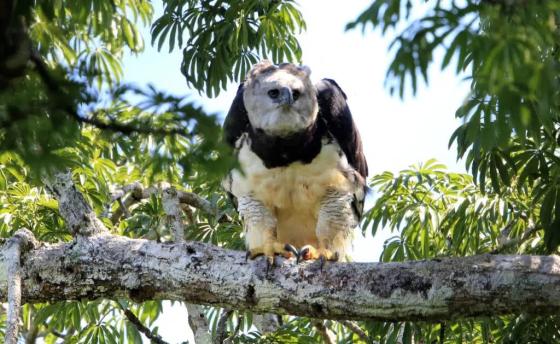Liberia: Nearly Half of All Bird Species in Decline

Harpy Eagles nest on large, old-growth trees often targeted by logging © feathercollector/Shutterstock
The latest State of the World’s Birds report paints the most concerning picture yet of the future of avian species and, by extension, all life on Earth.
Nearly half of all bird species were found to be in decline, with many populations severely depleted. One in eight bird species is currently threatened with extinction. Published every four years by BirdLife International, the report summarises what birds tell us about the state of nature, the pressures upon it, the solutions in place, and those needed.
The report concludes that one of the most important actions required is to effectively conserve, safeguard and manage the most critical sites for birds and biodiversity.
Currently, almost half of bird species worldwide are in decline, with just 6% increasing. While data on long-term trends in bird populations are most comprehensive for Europe and North America, there is increasing evidence that declines are occurring around the globe – from forest and wetland species in Japan to raptors in Kenya.
In addition to showing the dramatic declines of bird populations globally, the State of the World’s Birds 2022 report also details what is driving these losses:
- Agricultural expansion and intensification is the single biggest threat to the world’s birds, affecting 73% of all threatened species.
- Increased mechanisation, the use of agrochemicals and conversion of grassland to cropland has caused farmland birds in Europe to decline by 57% since 1980.
- In Ethiopia, the loss of grassland habitats to farmland since 2007 has caused an 80% decrease in the numbers of Liben Larks – an endemic species found nowhere else on earth.
- Unsustainable logging and forest management are also significant issues, with the loss of over 7 million hectares of forest each year impacting half of all threatened bird species.
- Climate change is also a considerable threat, and is already showing devastating impacts on the world’s birds. 34% of threatened species are already impacted and our changing climate is projected to rapidly become even more of an issue.
The Convention on Biological Diversity meeting (CBD COP 15) taking place later this year will be a crucial moment for birds and all nature, as governments convene to finalise and adopt the Global Biodiversity Framework.
“Birds tell us about the health of our natural environment – we ignore their messages at our peril. Many parts of the world are already experiencing extreme wildfires, droughts, heatwaves, and floods, as human-transformed ecosystems struggle to adapt to climate change. While the COVID pandemic and global cost of living crisis have undoubtedly diverted attention from the environmental agenda, global society must remain focused on the biodiversity crisis,” Patricia Zurita, CEO of BirdLife International
State of the World’s Birds 2022 also shows the solutions needed to address the biodiversity crisis, many of which are being put in place across the world. Safeguarding and protecting important sites for nature, restoring damaged ecosystems, and tackling key threats to birds and biodiversity are all critical.
One of the most urgent actions is to effectively conserve, safeguard and manage the most critical sites for birds and biodiversity – Important Bird and Biodiversity Areas (IBAs), over 13,600 of which have been identified by BirdLife International. IBAs form the core of a wider network of Key Biodiversity Areas and are increasingly being used to target the designation of protected areas.
They will be particularly important for ensuring that efforts to expand protected areas to cover 30% of land and seas are targeted to the most important locations.
Despite the desperate state of the natural world, birds provide us with reasons for hope. They show that with effective action, species can be saved and nature can recover. Since 2013, 726 globally threatened bird species have directly benefitted from actions of the BirdLife Partnership and over 450 Important Bird and Biodiversity Areas (IBAs) have been designated as protected areas through the advocacy efforts of BirdLife Partners.4
“Birds show that we are in an extinction crisis, with at least 187 species confirmed or suspected to have gone extinct since 1500. There is no denying that the situation is dire, but we know how to reverse these declines. Our research shows that between 21 and 32 bird species would have gone extinct since 1993 without the conservation efforts undertaken to save them. Species like the Echo Parakeet, California Condor, Northern Bald Ibis, and Black Stilt would no longer exist outside museums were it not for the dedicated efforts of the many organizations in the BirdLife Partnership and beyond. If we give nature a chance, it can recover,” Dr. Stuart Butchart, Chief Scientist at BirdLife International
The latest global IUCN Red List assessments for birds show that 1,409 species are considered threatened: 755 are listed as Vulnerable, 423 as Endangered, and 231 as Critically Endangered. This equates to 12.8% of all extant bird species or just over one in eight.
State of the World’s Birds is based on analyses of BirdLife's assessments of the extinction risk of over 11,000 bird species, its data on over 13,600 Important Bird and Biodiversity Areas, and an extensive review of the scientific literature published since the last report in 2018, and information from the 119 national nature conservation organizations around the world that form the BirdLife International Partnership.
BirdLife International is a strategic global partnership of conservation organizations in over 115 countries, working to conserve birds, their habitats, and global biodiversity, and to promote sustainability in the use of natural resources.
Find out more: www.birdlife.org
